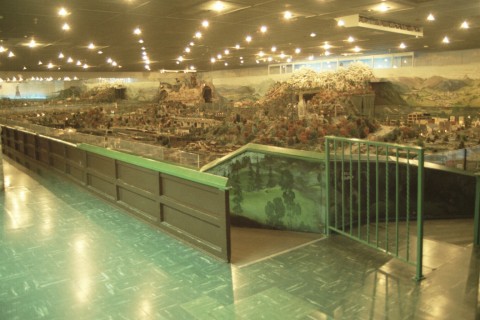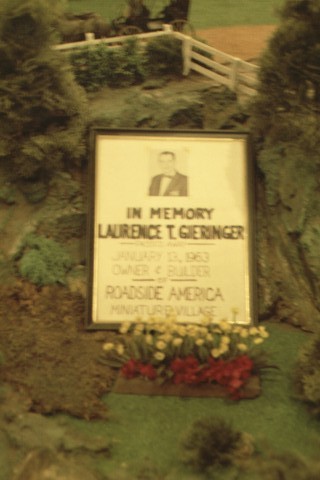
Roadside America Info Page
from the brochure:

Roadside America is the result of two young boys sharing a 'boyhood dream'. Most children, at one time or another, entertain thoughts of fantasy and achievement, but few ever apply these youthful concepts and make them into reality.
Laurence Gieringer was but 10 years old and his brother Paul was eight when they never thought that their idea would develop into a 'hobby' which would demand imagination, time, patience and arduous work.
Never did they think that this 'hobby' would flourish and be enjoyed by hundreds of thousands of people; people who enjoy and appreciate beauty and workmanship.
During the turn of the century, many years before television, talking pictures and radio, it was customary for the youngsters who grew up in the area of Reading, Pennsylvania, to play in the fields and the woods. This was their playground. It was also common for them to spend an afternoon climbing Neversink Mountain, which overlooked the city of Reading. The children loved to look down at the city, lying miniature-like at their feet.
Laurence Gieringer, then five years old, was no different than the other boys. From his back yard, he could see the mountain and the beautiful white building which dotted its top. This was the Highland Hotel. At night, Laurence would stand at his bedroom window and gaze in amazement as the lights glttered and twinkled from this building, giving it a fairy-like atmosphere. From his window, the building in the distance looked small enough for him to pick up and carry home. One afternoon the urge to see the white building up close was so strong that Laurence wandered away from the safety of his back yard, scampered through the woods, and attempted to climb the mountain and bring back with him the 'toy house'. Laurence never quite reached the top for he wandered into an abandoned sand hole and couldn't find his way through the bushes and trees. The inevitable happened; he got lost and it wasn't until the next morning that he was found by searchers.
At about 10 years of age Laurence together with his brother Paul, climbed to the top of Mt. Penn, overlooking Reading. There the boys looked down on the town lying miniature-like at their feet. They began rolling rocks down the mountainside discussing in their boyish way all the historical facts which occurred in the area. Dad and Mother Gieringer often told stories of how the two sons of William Penn planned the city of Reading. Laurence turned to Paul and said, 'Say Paul, wouldn't it be swell to make little houses the way they appear from here. Future generations could see how things are now!" "Swell!" replied Paul,' But where do we start?'
The two brothers told their parents of their desire to make little houses. This pleased the parents so much that dad made them a little workbench in the cellar and gave them the necessary tools. He instructed them in the use and care of the tools. Mother was also a great help for she allowed them the use of the kitchen table when the cellar was cold and damp.
The boys began to work in ernest. To earn money to finance their hobby, the brothers were compelled to do odd jobs such as hauling ashes, shoveling snow, passing out circulars, and selling popcorn and pretzels. The money earned was used to purchase nails, glue, mica, paint, etc. Dad rarely contributed his money to the project for he made it understood that the small income he had was needed to support his large family.
Each day, after the evening meal, the boys would finish their school work and immediately start to work on their miniature houses. Encouragement was given by Mother and Dad Gieringer. Mother never complained of the dirt. She was glad that the boys were at home and out of trouble. 'God Bless Our Home,' she would read aloud from the plaque which hung over the doorway.
At school, the boys were further enheartened by Sister Mary Concordia of the Order of Christian Charity, who was an artist in her own right. Every Saturday afternoon, while other boys were playing, Larry and Paul devoted their time to taking drawing lessons from the nun. Each lesson would cost 3 cents; the price of pencils and paper.
The two brothers worked together for seven years. Paul Gieringer answered the call to the priesthood. Before they parted, Paul persuaded Larry to continue in his work. From then on Larry worked alone. (Monsignor Paul Gieringer was head of the Josephinian Pontifical College in Worthington, Ohio.)
Upon moving to another part of town, Larry attended public school, where Miss Elizabeth Humma, a very understanding teacher, saw a real future in Laurence's non-academic work. She made him certain concessions, providing he promised to attain a fair average in his school work.
At the age of 16 Larry realized he'd have to go to work so he decided to expand his interests to the Printing Trade. Printing made some demands on his creative talent, but he wasn't satisfied. Being adept with tools, he became a carpenter and then a painter.
But he never stopped making model buildings for this was his hobby. Fervently, piece by piece, he whittled at blocks of wood, fashioning them to his dream - a miniature village. A church, a bridge, a horse-drawn carriage, a stable, a farm house - a boyhood dream being shaped into reality.
It is easy to see that Laurence was very serious in his enterprise. Everywhere he went he made sketches of buildings, arms, etc. He knew nothing of how to draw to scale, yet made up an arbitrary 3/8" to the foot and has adhered to it in all his modeling.
Laurence Gieringer married Dora Seisler, the girl who lived but a few doors from the Gieringer home. They grew up together enjoying each other's company and interests. She helped Laurence in his hobby, never once losing faith in her husband even when indebtedness and hardship stalled his efforts. She is creditied for making the shrubbery and trees which beautify the landscape at Roadside America
Larry and Dora had two children, Paul and Alberta. The children helped in many ways. All the detailed work and figure painting was their responsibility.
Laurence made many trips to New York City in those early days of his career, always visiting the American Museum of Natural History and The Metropolitan Museum of Fine Arts and studying the miniatures.
He was struck by the absence of stained glass windows in every miniature he saw, and so he was determined to make some for his own models.
For three years he experimented with different mediums and gums to create the colors to stain glass. Finally after innumerable disappointments, he achieved three primary colors, and with these he then painted strips of glass. In order to test which would stand up under various atmospheric conditions he covered each piece half way with heavy brown paper leaving the balance exposed. Only the best were used.
Laurence left nothing daunt his creative genius. During the depressions years he increased his activity. His perserverance coupled with the industry, had not escaped the notice of his neighbors and friends. Even country auctions heard of him and one friend suprised him by sending up a three-ton truck load of old furniture when he had been unable to sell at an auction. It was well seasoned, solid wood admirably suited for model-making as it would not warp.
The years of toil, evidenced in wood carvings, grew in scope. Christmas of 1935 came along and Gieringer, as usual, set up a pert of his miniatures for his children. The Reading Eagle Newspaper, hearing of the splendor of the exhibit, featured the story. Interest grew and the Rainbow Fire Company donated the use of their building for the display, all earnings going to local charities. As a result, the Gieringer miniatures officially became a public exhibit. In 1938, a 1,500 square foot exhibit was set up at Carsonia Park. The Gieringer miniatures at this time were proclaimed by newspapers, magazines, and newsreels, as the World's Greatest Miniature Village and the most unique and detailed masterpiece ever evolved by the ingenuity of men.
In 1941, the exhibit was brought together under one roof and opened near Hamburg. It continued to grow in size, in interest and beauty and now has been relocated in a larger building surrounded by woodlands just west of Shartlesville where the result of this 'hobby' can fully be appreciated.
Today, the entire Bernecker family, daughter and family of the original designer, continue to maintain and operate Roadside America for you to enjoy.

Tips? Photos? Please share:
World's Largest Things
PO Box 101
Lucas, KS 67648
info@WorldsLargestThings.com
| Home | | Store | | Become a Member | | What's New | | What's Large Where |
copyright and trademark ERNCO Value Added Products and World's Largest Things